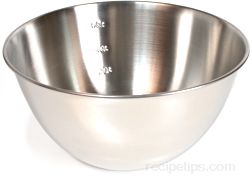
A non-reactive pan pot is made of. All-Clad is non-reactive because there is never any aluminum inside.

Lining reactive pans with a nonreactive interior surface like stainless steel enamel or tin is one such strategy.
Stainless steel non reactive. Stainless steel is a non-reactive metal an excellent choice for both cooking and storing tomato sauce or other acidic foods. Bowls and cookware made from stainless steel will not alter the flavor of your foods and will not stain because of interacting with. Ceramics and stainless steel are considered non-reactive.
While these dont conduct heat very well and tend to have hot spots they wont interfere with the chemical structure of the food in such a way that changes the look or edibility of our food. Their other big advantage is that once theyre hot they stay hot for quite some time. Stainless steel is a non-reactive metal which means that you can use it to cook foods that are acidic like citrus tomatoes and vinegar.
Other metals like aluminum and iron are reactive and cooking acidic foods in these metals will affect the flavor and damage the surface of the metal. Systems for Stainless Steel Grades. Non-reactive types of product include stainless steel hard anodized glass ceramic enamelware clayearthenware and most nonstick surfaces.
A reactive pan is one that is made from materials that react chemically with some types of foods. The most common reactive product is made of aluminum not hard anodized copper and cast iron. Stainless steel ceramic glass and metal cookware with enamel coating are all nonreactive Foods cooked in reactive pots will often pick up a metallic flavor and sometimes turn funny colors this usually happens with very acidic or very alkaline foods.
Shoppers who are looking for new cookware that is non-reactive should choose stainless steel over cast iron copper or aluminum if they plan to cook acidic recipes. Furthermore cooks shouldnt forget to keep a reactive copper bowl on hand if they like to make. Which Pans have Non-Reactive Metals that are good for Acidic Food Stainless Steel finishes are great non-reactive metals.
Theyre durable especially if theyre 1810 stainless steel. CeramicGlass are considered non-reactive and completely safe. Ceramic coated interior are extremely popular in.
Stainless steel by itself is an extremely poor heat conductor. One may also ask is all clad non reactive. All-Clad is non-reactive because there is never any aluminum Aluminum on the inside cooking surface is what makes cookware reactive.
All-Clad is non-reactive because there is never any aluminum inside. Its either sandwiched between other layers or used on the outside. The above are non-reactive but tend to weaker conductors of heat when compared to the reactive ones.
There are also a set of exceptions to the common rule which are. Cast iron is reactive and heats well. There are many people who cook high-acid foods in a well-seasoned cast iron pan without recourse.
A non-reactive pan pot is made of. So your good quality stainless cookware is non-reactive. If you like me have any of the old glass Corning Visionware pots still hanging around they too are non-reactive.
Enameled cast iron like Le Creuset or general country-style enamelware are also non-reactive. All of these pots would be perfect when making. What is Non-Reactive Cookware.
Non-reactive cookware is any cookware that you can use without worrying about chemical reactions affecting your food. The most common materials used for non-reactive cookware are glass ceramic stainless steel enamel and tin. While non-reactive cookware is ideal for preparing and cooking any kind of food it is critical that you use this kind of cookware when.
Well non-reactive cookware is those which do not react to acidic ingredients that are present in your recipe. There is a lot of non-reactive cookware available in the market including stainless steel finish cookwares. Stainless steel finish cookware is most common and famous for not decolourising when acidic ingredients are used in them.
The most common nonreactive cookware is made with a stainless-steel finish and will not discolor or pit when used with acidic ingredients. You can see from the two saucepans above the finish on the one on the left nonreactive stainless-steel has remained intact and has not pitted whereas the lining and finish reactive in the copper pan has become worn off. Lining reactive pans with a nonreactive interior surface like stainless steel enamel or tin is one such strategy.
Another approach is to give a stainless-steel pan an exterior base or enclosed core of copper or aluminum. Aluminum can also be made nonreactive. Joined May 16 2003.
You dont need to worry about stainless steel or any other non-reactive metals for the brine. Non -reactive means materials that will not chemically combine with acids such as aluminum or copper. Feel free to add chile flakes and salt.
Stainless steal will not create a metal flavoring. Stainless steel is the most common non-reactive cookware available. Since it does not conduct or retain heat well it frequently has aluminum or copper bonded to the bottom or a core of aluminum between layers of stainless steel.
Although expensive this kind of cookware offers the benefits of a durable non-reactive surface and rapid uniform.